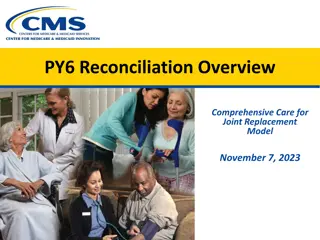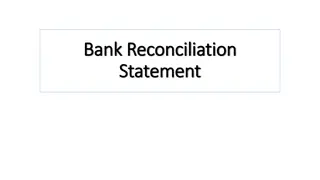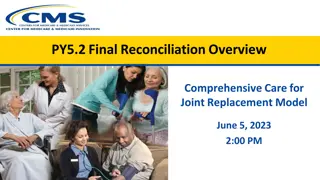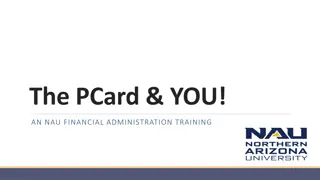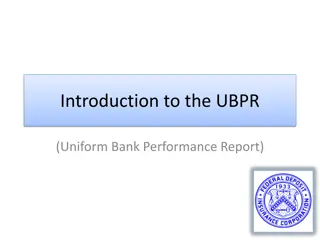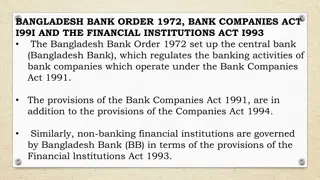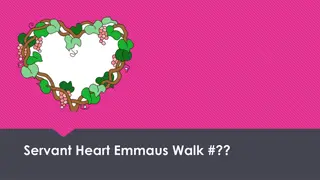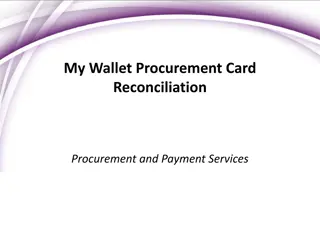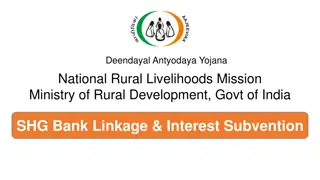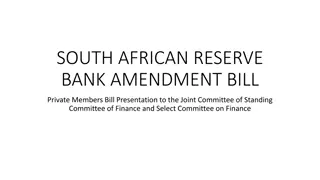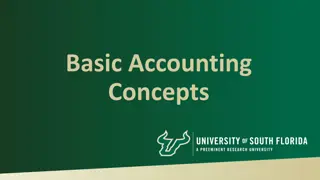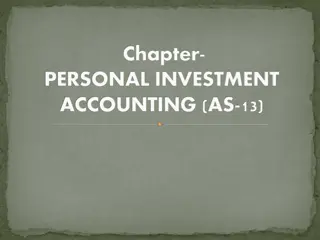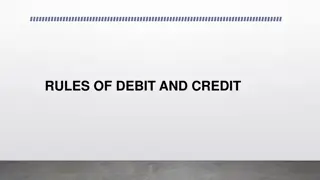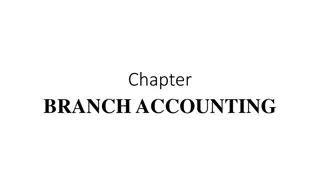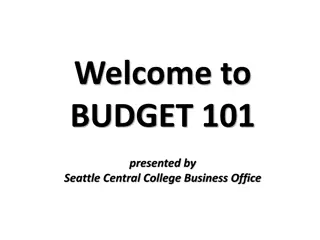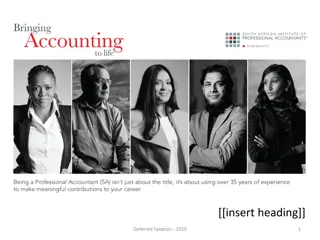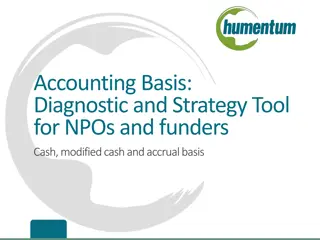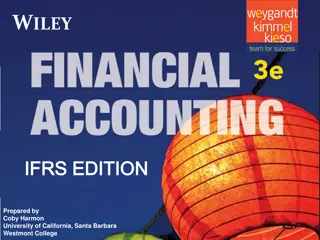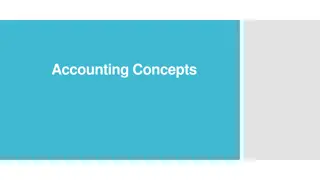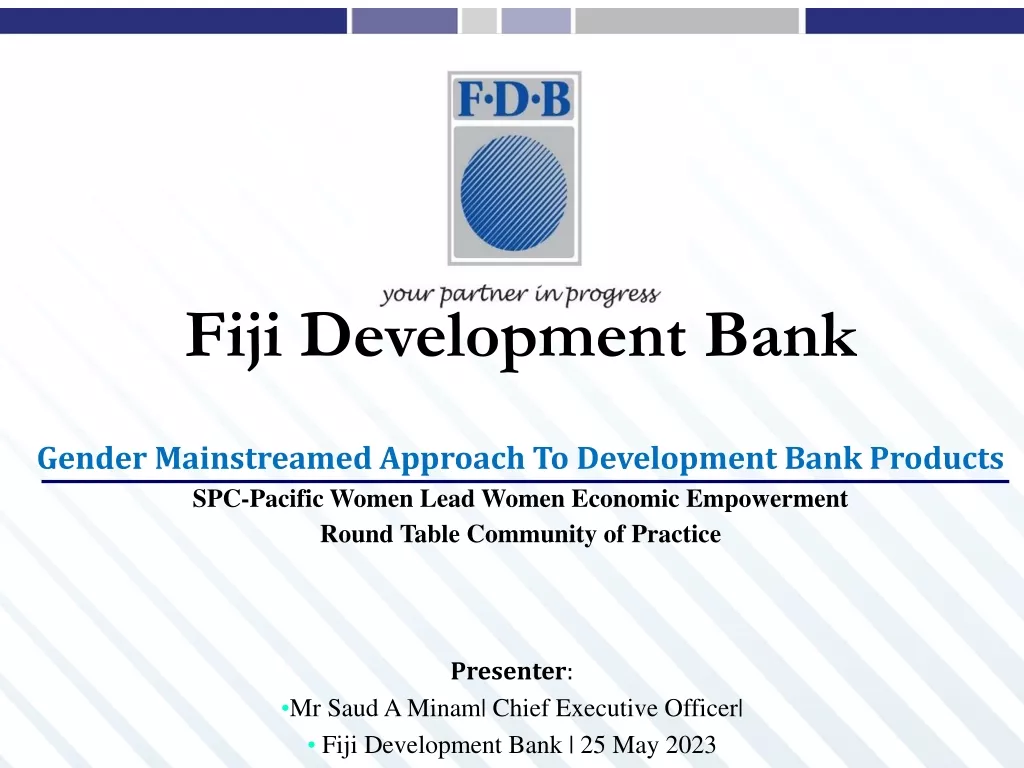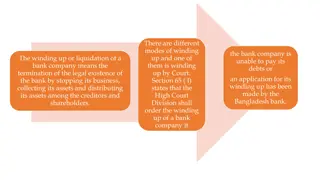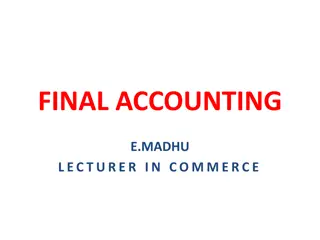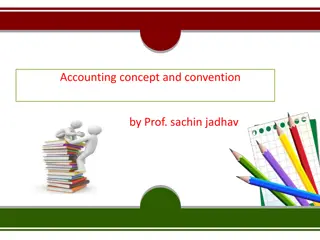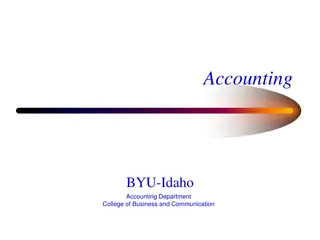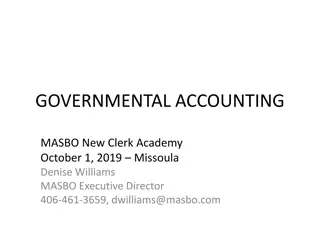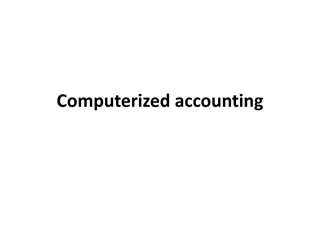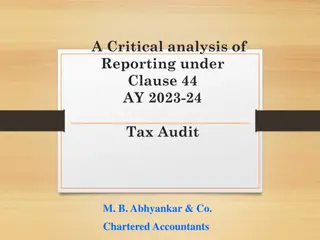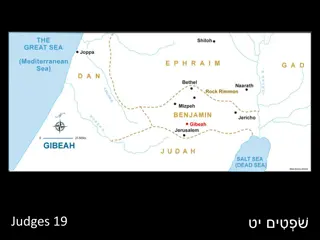Understanding Bank Reconciliation in Accounting
Bank reconciliation is a crucial process in accounting that involves comparing internal records with external bank statements to identify errors, omissions, and discrepancies. It helps ensure accuracy in financial transactions and internal controls. This topic is assessed in Grade 12 exams and requires a clear understanding of concepts, principles, and practical application. Educators and candidates should focus on real-life examples and current trends to enhance learning outcomes.
Download Presentation

Please find below an Image/Link to download the presentation.
The content on the website is provided AS IS for your information and personal use only. It may not be sold, licensed, or shared on other websites without obtaining consent from the author. Download presentation by click this link. If you encounter any issues during the download, it is possible that the publisher has removed the file from their server.
E N D
Presentation Transcript
GRADE 12 ACCOUNTING BANK RECONCILIATION
BASIC INFORMATION The topic Bank Reconciliation falls under Discipline 2 (Forecasting, Internal controls and Auditing) and will be assessed in Paper 2 in the Mid-year and Final examinations. 2 weeks allocated for Reconciliations in the ATP Extract from Diagnostic Report 2019 This topic is generally pitched as an easy to medium question, but the process of completing the reconciliation remains a problem for many candidates. This is a concern, as the basic application relevant to this topic is covered in Grade 11 and this topic appeared in different ways in many past examination papers. EXTRACT CHIEF MARKERS REPORT 2017 Preparing a bank reconciliation statement forms part of the Grade 11 syllabus. Grade 12 candidates are expected to analyze and interpret the information presented. Examiners are presenting information in different ways in order to be less predictable. They also introduce real-life examples such as EFTs and internet banking, but educators tend to present information in the stereotypical formats found in textbooks. Educators do not introduce learners to the current changes and trends in the real world.
EXPECTED OUTCOMES EXPECTATIONS: Clear understanding of concepts and principles relating to bank reconciliation. Identify errors and omissions and take the appropriate actions to deal with them. Draw up Bank Reconciliation Statement Integrate internal control process and ethics where relevant. Provide practical examples from real-life situations
WHAT IS A RECONCILIATION? It is an Internal Control measure or process Involves comparison of books as prepared by different parties (business and bank) Internal records (books prepared by the business) External information source (Bank Statement) Noting and rectifying differences ERRORS, OMISSIONS, CALCULATIONS, Bank
RECEIPTS, CHEQUE COUNTERFOIL, BANK STATEMENTS, PRIOR KNOWLEDGE CRJ, CPJ, The Accounting Cycle Cash transactions The Accounting Equation GENERAL LEDGER
BANK RECONCILIATION DEPOSITS CASH STATEMENT Business keeps records of all cash transactions CRJ and CPJ BANK ACCOUNT BRS Bank keeps record of the business s transactions BANK STATEMENT (reflected in the BS as Dr(-) and Cr(+) entries
RECONCILIATION PROCESS An entity and its bank conduct, on a daily basis, transactions that concern each other BUT which take place independently of each other. For example, the entity draws a cheque in favour of a supplier (i.e. payee or drawee). The bank is not aware of this transaction until the supplier (drawee) present a cheque to bank for payment, perhaps days or weeks later. This passage of time may stretch over to the end of a business month which will result in this cheque being included in the accounting records of the business, but not in the accounting records of the bank This cheque will be referred to as outstanding cheque in the BRS of the current month and other months until it is presented for payment Cheques are valid for 6 months (cheques older than that are stale cheques) This may happen in deposits received by the business but not yet taken to bank for deposit Post dated cheques issued, post dated cheque received
STEPS IN THE RECONCILIATION PROCESS 1. Compare the information in the Cash Journals and BRS of the previous month with the Bank Statement (dr and cr entries) We will tick the information that appears in the set of records as prepared by two parties, and highlight (circle) the information that appears in only ONE set of records. What are we looking for?
2. Update the CRJ and CPJ with relevant information on the Bank Statement (supplementary cash journals and the first entry in both journals are the provisional totals) 3. Post the adjusted totals to the Bank Account in the General Ledger to determine the correct balance as per the Bank Account. THE STATEMENT: Bank charges Interest Dishonoured cheques Direct deposits Debit orders Stop orders OUR BOOKS: The BRS might have amounts NOT appearing on the statement The CRJ might have deposits NOT on the statement The CPJ will indicate cheques NOT presented for payment.
4. Prepare the BANK RECONCILIATION STATEMENT The Reconciliation Statement will highlight: Items from the business s records (CRJ,CPJ&BRS prev. month) that are not on the statement; Errors on the statement made by the bank NOTE: Errors made by the business are corrected in the relevant business book. These entries will account for the difference between the Bank Account balance and the Bank Statement balance The Reconciliation Statement will serve as a source to check if the above have been addressed on the next Bank Statement
ADDITIONAL ENTRIES THAT MUST BE ADDRESSED ERRORS ON THE STATEMENT ERRORS (INCORRECT) AMOUNTS FOR CHEQUES IN THE CPJ MISSING DEPOSITS (PRUDENCE) LOST CHEQUES RE-ISSUED STOP PAYMENTS ON CHEQUES Extension Activities
PRACTICE TIME QUESTION 1 1.1 BANK RECONCILIATION The information below was taken from the accounting records of Clara Traders, owned by Clara Johnson. REQUIRED 1.1.1 Calculate the correct totals for the Cash Receipts Journal and the Cash Payments Journal for October 2019 by completing the table provided. 1.1.2 Calculate the correct balance in the Bank Account on 31 October 2019. State whether this balance is favourable or unfavourable. 1.1.3 Prepare the Bank Reconciliation Statement on 31 October 2019. 1.1.4 Refer to information E. Explain TWO internal control measures the business should implement to prevent such incidents in the future. (8) (5) (8) (4)
INFORMATION INFORMATION A. Information taken from the Bank Reconciliation Statement on 30 September 2019: Favourable balance of the bank statement R 9 670 Outstanding deposit R 10 100 Outstanding cheques No 1101 (date: 28 April 2019) R 8 400 No 1128 (date: 27 Aug 2019) R 7 800 No 1134 (date: 23 Sep 2019) R 7 500 Credit unknown debit on statement R 8 000 Debit balance as per Bank account R 4 070
INFORMATION B. Provisional totals: Cash Receipts Journal: Total R59 035 Cash Payments Journal: Total R50 760 C. The Bank Statement for October 2019 reflects the following items which did not appear in the Cash Journals: A deposit of R10 100 Cheque No 1128 A cheque received from H. Andrews, a debtor, R1 500, as settlement of his account of R1 650, marked R/D because of insufficient funds. Rent received from D. Taylor, R12 400 per electronic transfer. Stop order for R1 400 in favour of ZZ Insurance for insurance. An unknown debit entry of R 8 000. An investigation determined that this payment as well as the R8 000 in the September Bank Reconciliation Statement was part of a fraud scheme and was illegally taken from Clara Traders bank account. The bank will reverse these amounts in the next bank statement. Bank charges, R620
INFORMATION D. The following items appear in the October 2019 Cash Journals: A deposit of R18 000 Cheque no 1194 (15 October 2019), R3 610. Cheque no 1126 (18 November 2019), R13 000. E. Additional information A cash deposit of R5 400 was stolen from the bookkeeper as he was on his way to the bank. This amount must be written off as it will not be recovered.
SUGGESTED SOLUTION QUESTION 1 1.1 BANK RECONCILIATION 1.1.1 Calculate the correct totals for the Cash Receipts Journal and the Cash Payments Journal for October 2019 by completing the table provided. CRJ 59 035 Stale cheque 8 400 H Andrews Rent 12 400 79 835 CPJ 50 760 1 500 1 400 5 400 620 59 680 Insurance Loss of cash Bank charges
SUGGESTED SOLUTION 1.1.2 Calculate the correct balance in the Bank Account on 31 October 2019. State whether this balance is favourable or unfavourable. 5 4 070 + 79 835 59 680 = 24 225 Favourable
ADDITIONAL INFORMATION 1.1.3 Prepare the Bank reconciliation statement on 31 October 2019. Bank reconciliation statement on 31 October 2019 Favourable/Credit balance as per statement Debit Credit 14 335 Credit outstanding deposit 18 000 Debit outstanding cheques Nr. 1134 7 500 Nr. 1194 3 610 Nr. 1226 13 000 Credit unknown/fraudulent debits 16 000 (8 000 + 8 000) Debit balance as per bank account 24 225 48 335 48 335
SUGGESTED SOLUTION 1.1.4 Refer to information E. Explain TWO internal control measures the business should implement to prevent such incidents in the future. Award part marks for partial answers Let the bank/cash in transit company collect the money Use a drop box safe that only the bank can open Keep money hidden/out of sight.


